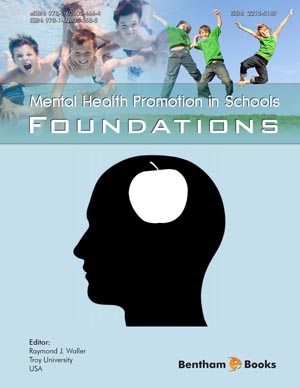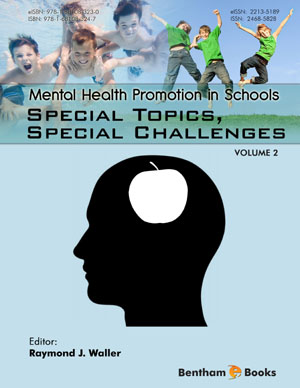Foreword
Page: i-i (1)
Author: Christine Robinson
DOI: 10.2174/97816080506591100101000i
Preface
Page: ii-ii (1)
Author: Rosie Ilett and Alison Bigrigg
DOI: 10.2174/9781608050659110010100ii
Contributors
Page: iii-iv (2)
Author: Rosie Ilett and and Alison Bigrigg
DOI: 10.2174/978160805065911001010iii
Abstract
Full text available
Why Sexual Health is Important
Page: 1-11 (11)
Author: Alison Bigrigg and Rosie Ilett
DOI: 10.2174/978160805065911001010001
Abstract
The introductory chapter describes the motivation for the collection - to explore the cultural, social and organisational context of sexual health in twenty-first century Scotland. Written by the book's co-editors, it argues that good sexual health is vitally important, and its absence linked to social inequalities, often to discrimination and disempowerment.
The development of the first national sexual health strategy in Scotland forms the book’s core, and the chapter explains why Scotland, as a devolved part of the UK, with its own government and health care system is the site for investigation. Population health in Scotland is notably worse than the rest of the UK, with health and social inequalities prominent. This context has enabled responses to emerge in relation to sexual health that the chapter suggests are of wider interest and the chapter briefly describes population demographics of Scotland, its political and geographical landscape, historical and contemporary attitudes towards sex and sexual activity, and earlier policy thinking and the type of sexual health services provided.
The structure for the book is set out, based on four sections - the social, political and cultural context; structures and services developed through the sexual health strategy; sexual health service innovation, and cross-cutting issues around partnership and integration – with information given about the authors. The chapter finishes by proposing that a momentum has begun in Scotland around sex and sexual health, and that this collection, whilst concerned about the implications of the current economic climate, argues for optimism and hope for the future.
Is Scotland’s Health Different from the Rest of the UK - and Why?
Page: 12-17 (6)
Author: Phil Hanlon
DOI: 10.2174/978160805065911001010012
Abstract
This chapter provides evidence for, and explores reasons why, understanding the poor nature of public health in Scotland is vital to understanding sexual health. As Chair of the Expert Reference Group that devised the first national sexual health strategy for Scotland, and an expert on public health, Professor Hanlon's synthesis illuminates the relationships between inequalities and poor health outcomes, and provides a convincing link to modernity, where norms around consumption and gratification have extremely negative results for individuals and society.
The chapter investigates Scotland's poor health status in comparison with the rest of the UK, and provides population data concerning morbidity and mortality to demonstrate this. Explaining that social and economic deprivation, coupled with the collective and individual experience of postindustrialisation, is often perceived as the main cause for Scotland's poor health, the author proposes that an additional and increasing excess mortality in Scotland, known as the Scottish effect, exists beyond these explanations. This effect is still not fully understood, and other possible contributory factors such as the environment, weather conditions and culture and social mores are discussed. Culture is discussed in detail as an important component of health and wellbeing, and one that may well have a critical impact on individual and collective health experiences. The chapter concludes by saying that it is essential to adopt a multi-disciplinary approach to exploring and investigating the patterns of ill health in Scotland in order to understand and address them further.
What are Scotland’s Sexual Health Challenges?
Page: 18-26 (9)
Author: Shirley Fraser
DOI: 10.2174/978160805065911001010018
Abstract
The concluding chapter in the first section provides an insider view of the development of Respect and Responsibility - the first sexual health strategy for Scotland. Written by Shirley Fraser, a leading expert in sexual health policy-making in Scotland, it describes the experiences and challenges in identifying policy and service responses in sexual health that are acceptable to the public, to clinicians and managers in the NHS, to national and local government, and the array of interest groups and communities of interest. The chapter reflects back on the last two decades, during which significant social, cultural and organisational shifts concerning sexuality and sexual behaviour have occurred in Scotland and elsewhere, specifically focussing on activity and thinking before and since the strategy.
The author covers the political and policy pressures and opportunities surrounding the Scottish strategy, and describes parallel activity in national sexual health policy elsewhere in the UK. The structures that were established to create and oversee the implementation of Respect and Responsibility are charted, alongside the strong political support that the devolved Scottish Government (of successive political complexions) has provided. The chapter asserts that the Scottish strategy (although changed from draft to final outcome) contains a broader understanding of sexual activity, and the social determinants of sexual ill-health, than others in the rest of the UK, with the adoption of a population health approach, and the decision to see children and young people as a critical target group, but not to the exclusion of others, differentiating the Scottish perspective.
The Development of Sexual Health Service Standards for Scotland
Page: 27-38 (12)
Author: Rak Nandwani
DOI: 10.2174/978160805065911001010027
Abstract
This chapter opens the second section of this collection by explaining the process by which the new national sexual health clinical quality standards were devised and put into operation across Scotland. The author, Dr Rak Nandwani, was clinical adviser at NHS QIS during this period and presents their importance to the implementation and delivery of Respect and Responsibility - Scotland's sexual health strategy. The Standards themselves are included for reference, and a full commentary of their development given.
Describing the background to the strategy, the author demonstrates the associated need to formulate a coherent set of standards that embodied the expectations of the strategy and that would also provide markers of progress applied across Scotland by NHS Boards to improve sexual health and to meet Scottish Government targets. Drawing on the authors' close involvement in the evolution of what have become known as the QIS Standards, he describes the various tensions and challenges in their formulation and the iterative and consultative approach that were adopted. This was to guarantee that the statements contained clinical quality at a population level, and in relation to target groups for sexual health; as well as to ensure that they progressed the holistic model to sexual health improvement that was needed, and that they were supported by clinicians, commissioners, interest groups and other stakeholders. The chapter describes how the Standards will be monitored, once implemented, and their close relationship to the national sexual health data and information systems in Scotland.
Key Clinical Indicators for Sexual Health: Current National Sexual Health Data Collection and Future Plans
Page: 39-44 (6)
Author: Felicity Naughton and Jim Chalmers
DOI: 10.2174/978160805065911001010039
Abstract
The service improvements in sexual health across Scotland that this collection discusses have required the underpinnings of timely, accessible and accurate information to inform and facilitate activity and to monitor its outcomes. This chapter contributes to the section in this collection on the delivery infrastructure. It sets out the role of national data and information services in recording and reporting sexual health activity across the Scottish health care system, as aligned to the targets set out in the NHS QIS Standards, which the last chapter covered. The need for excellent intelligence to inform both national and local planning, and to better understand sexual ill-health and inequalities across Scotland, is clearly conveyed and demonstrated in this chapter written by two of the central players - Dr Jim Chalmers and Felicity Naughton - in the formulation and delivery of the national sexual health information system that is part of the central support system for the NHS in Scotland.
The chapter gives an insight into the various sources of national sexual health data, including clinical reporting from services across Scotland, public surveys and qualitative material, and of the uses to which it can be employed – in a systematic way, through the Information Services Division information dissemination system, and in an ad-hoc way, in response to Government requests for example. The authors ably demonstrate in this chapter the cohesive nature of the systems and the critical role that the intelligence generated has in sexual health improvement, informing policy-making and the employment of resources.
Managing Patients Differently - The Scottish National Sexual Health IT System (NaSH)
Page: 45-58 (14)
Author: Andrew J Winter
DOI: 10.2174/978160805065911001010045
Abstract
The concluding chapter in this section of the book provides a comprehensive review of the evolution of the Scottish sexual health patient information system - NaSH, and its eventual implementation. With all NHS Health Boards, at the time of writing, either using or about to introduce NaSH, this is a significant achievement, given the previous patchy nature of sexual health patient records in Scotland as the chapter describes. Dr Winter, a GUM consultant and expert in sexual health information management, was part of the group behind the NaSH system, and conveys the multiple strands that NaSH needed to incorporate, and the internal and external challenges that needed to be overcome.
The NaSH system was funded by the Scottish Government to support increased access to services and to bring all sexual health services in Scotland into the 21st century in IT terms in line with the inception of the Sexual Health Strategy. It needed to meet the needs of national governance and local commissioners for robust information about client uptake, service efficiency and sexual health demographics; of clinicians and NHS managers for a workable and efficient system that maximised client outcomes; and of clients for a system that made services increasingly accessible yet protected confidentiality in a highly sensitive clinical area. The commissioning and tendering process for the NaSH system is described, and a range of tables and documents drawn from the development process included that illuminate the complexity of the system, and the issues that had to be addressed.
Scottish Sexual Health Services: Cinderella Starts Making her Way to the Ball
Page: 59-67 (9)
Author: Alison Bigrigg and Anna Glasier
DOI: 10.2174/978160805065911001010059
Abstract
A central objective of Respect and Responsibility - Scotland's first national sexual health strategy - was to improve sexual health services through developing strong local and national alliances. This chapter by two of Scotland's sexual health clinical leaders, Dr Alison Bigrigg of the West of Scotland Managed Clinical Network and Professor Anna Glasier of NHS Lothian, reviews the resulting organisational arrangements and the key roles given to the NHS in Scotland and their local authority partners to take a holistic view to the Scottish sexual health landscape.
Summarising the previous structures of sexual health care, and the players involved, the chapter charts the shift to a more innovative environment by describing examples of good practice from across Scotland that have resulted from these opportunities, and from the funding that came to local areas through the Strategy. This includes work to support young people in Lothian; innovative developments in the West of Scotland; a managed sexual health clinical network Grampian; an enhanced sexual health role for community pharmacists; a national campaign to raise awareness of long acting reversible contraception (LARC), and partnership working in Dumfries and Galloway.
The sexual health strategy aimed to reduce inequalities in access to sexual health services, and the authors argue that these, and other examples of sexual health care in the 21st century go a long way to improving the previous landscape of sexual health services in Scotland.
The Story of Sandyford - Developing Accessible Sexual Health Services in the West of Scotland
Page: 68-80 (13)
Author: Rosie Ilett
DOI: 10.2174/978160805065911001010068
Abstract
The second chapter in the section covering contemporary sexual health services focuses on the largest sexual health service in Scotland, the Sandyford Initiative in Greater Glasgow and Clyde. This service pre-empted the first national sexual health strategy for Scotland in its integration of family planning and genitourinary medicine in 2000, and the chapter details the local conditions that led to this development, much of which are linked to previous multi-agency working concerning inequalities and health.
Written by one of the founders of the Initiative (also one of the book’s editors) the chapter reviews thinking that informed the merger between family planning, GUM and a women’s health service in Glasgow. It describes how integrating understandings of health and social inequalities into the planning and delivery of the service was seen as critical, and employed as a vision in bringing staff together to form one cohesive unit.
Drawing on internal documents and early evaluations of the views of staff and service users at the start of the service, along with a summary of activity and outcomes since then, the chapter sets out to discover how successful Sandyford has been in embedding an inequalities sensitive approach since its opening. It concludes that organisational culture has a high level of understanding about inequalities, and the service has reached a wider range of service users than before integration, yet the current economic climate may prove increasingly challenging in ensuring that the ethos continues to remain central.
Health Improvement Perspectives: Transformation Within Services Through Reaching Out
Page: 81-86 (6)
Author: Phil Eaglesham
DOI: 10.2174/978160805065911001010081
Abstract
The final chapter in this section - Chapter 9: Health improvement perspectives: transformation within services through reaching out – continues to explore the importance of taking a broad model of sexual health into conceptualising sexual health and in targeting activity to those most vulnerable to poor sexual health outcomes. The first sexual health strategy for Scotland emphasised the need for this approach, and in this chapter Phil Eaglesham from NHS Health Scotland describes the significant role of health improvement in promoting good sexual health in Scotland and reviews its contribution to population health.
Mr Eaglesham gives an overview of the tenets of health improvement practice in Scotland and the UK, and provides evidence of work from a health improvement perspective to address the needs of those most at risk of poor sexual health outcomes and to advocate for improved outcomes. These include men who have sex with men, as well as young people as a group, and examples are given of good practice in sexual health improvement especially in relation to partnership working, linked to specialist services and supporting multi-agency approaches.
Two examples from Greater Glasgow and Clyde, Archway – for those who have been recently raped or seriously sexually assaulted, and Open Road – for men involved in prostitution, are given as useful case studies. The chapter ends by suggesting that sexual health improvement approaches contribute to broader population health in Scotland by often providing the only routes for rapid access to healthcare and support for those marginalised in our society.
Modernising a New Workforce Fit for Purpose in Sexual Health
Page: 87-94 (8)
Author: Lorraine Forster, Martin Murchie and Urszula Bankowska
DOI: 10.2174/978160805065911001010087
Abstract
This chapter continues the book’s theme concerning partnerships and integration, and focuses on the implications for the clinical workforce of service integration within sexual health. Written by three clinicians from a range of sexual health disciplines, based at the Sandyford Initiative - Lorraine Forster, Dr Urszula Bankowska, Martin Murchie – it reviews the clinical environment before integrations took place and the training needs of specialities and disciplines, and the role of recent government policy in influencing the shape of the sexual health workforce.
The chapter describes the new skills and competencies required by medical and clinical disciplines to deliver integrated sexual health services. It suggests examples of good practice to effect that change from nursing, medical and health advising perspectives. The responsibility of national training agencies in supporting staff training, such as NHS Education Scotland (NES), Royal College of Nursing (RCN), the Faculty of Sexual and Reproductive Health (FSRH) and the British Association of Sexual Health and HIV (BASHH) is described.
The chapter concludes that there are a number of challenges ahead that will impact on sexual health care and maintaining a skilled workforce, including the availability of budgets to continue developing sexual health services, responding to changing population health needs and workforce issues. The authors argue that strong networks, professional identities and accredited clinical skills can only help to ensure that the sexual health workforce continues to make a valuable contribution to public health in Scotland.
Partnership Working and Multi-Agency Approaches
Page: 95-102 (8)
Author: Andrew Gardiner
DOI: 10.2174/978160805065911001010095
Abstract
The final chapter in this section of the book, and of the overall collection, turns its attention to the role of other agencies beyond the NHS in affecting sexual health improvement and the nature of partnership arrangements to deliver desired change. The clear expectations in Respect and Responsibility (Scotland’s first national sexual health strategy) of multi-organisational working, especially between the NHS, local authorities and the voluntary sector, to address sexual health needs in Scotland have needed creative responses. These are reviewed by the chapter’s author, Andrew Gardiner from NHS Grampian, and structures that have been put in place to facilitate partnership working across Scotland are described. These include recent requirements, through the introduction of Single Outcome Agreements and Community Planning, by Scottish Government of local authorities in Scotland to ensure that health improvement is addressed in partnership.
Examples of successful joint working from across Scotland are given that suggest where lessons could be learned for the future, especially concerning the most vulnerable population groups and indicate where useful groundwork has started.
References
Page: 103-112 (10)
Author: Rosie Ilett and Alison Bigrigg
DOI: 10.2174/978160805065911001010103
Abstract
Full text available
Subject Index
Page: 113-121 (9)
Author: Rosie Ilett and Alison Bigrigg
DOI: 10.2174/978160805065911001010113
Abstract
Full text available
Introduction
This edited collection provides a unique insight into sexual health in Scotland. It sets out the challenges facing Scotland in terms of poor sexual health and inequalities, within devolved government arrangements and a different healthcare system from the rest of the UK. It suggests that these factors have facilitated the development of an integrated model of sexual health planning and delivery with resonance beyond Scotland. Chapter authors include clinical specialists, managers and policy-makers, academics and senior government officials from Scotland and other parts of the UK, all of whom have an active role in commissioning, delivering or commenting upon sexual health services or sexual health. Both editors have significant experience in developing, delivering and managing innovative sexual and reproductive health services and have held national and international leadership and advisory roles concerning health policy and service management. They were instrumental in developing and delivering Sandyford, NHS Greater Glasgow and Clyde’s sexual health service – the largest in the UK and viewed as the UK leader in progressive service development












